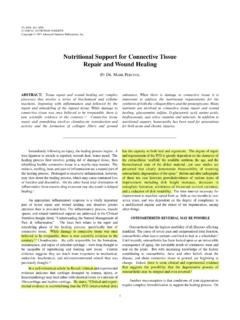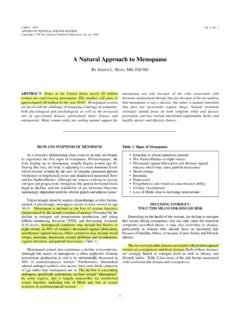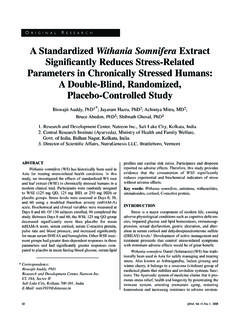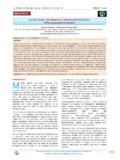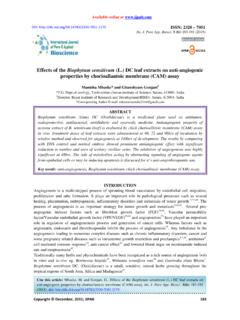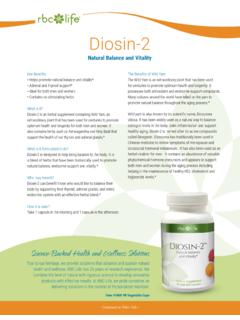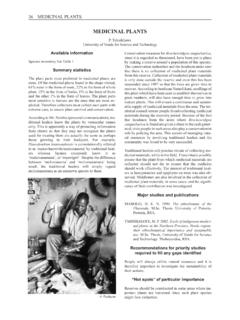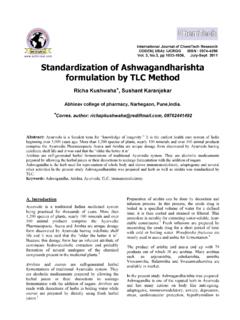Transcription of Black Cohosh and Chasteberry: Herbs Valued by …
1 Black Cohosh and Chasteberry: Herbs Valued by Women for CenturiesBYJOSEPHL. MAYO, MD, FACOGCNI615 7/98 CLINICAL NUTRITION INSIGHTSC opyright 1998 Advanced Nutrition Publications, 6, No. 15A woman s quality of life is often associated with a healthy hormonalbalance throughout her reproductive and menopausal in hormone balance can lead to menstrual disorders suchas irregular bleeding and heavy bleeding, symptoms of premenstrualsyndrome (PMS), as well as menopausal complaints later in is a strong need for therapies to treat these problems, as it isestimated that over 30% of all women experience symptoms of PMSduring their reproductive addition, 3,500 women enter theirmenopausal years every day in the , the majority of whomexperience significant Western medicineaddresses these concerns with pharmaceuticals, often withundesirable side effects, Herbs such as chasteberry (Vitex agnus-castus)
2 And Black Cohosh (Cimicifuga racemosa) offer an option forwomen who would like a safe, natural approach to reducingmenstrual cycle and menopausal ,4 [For a more detailed discussion of PMS, menopause, and themenstrual cycle, please refer to our previous Clinical NutritionInsights:Vol. 5, No. 6-9]WOMEN ARE ENRICHED BY A GREEN PHARMACYFrom the beginning of time, women have had a specialrelationship with the earth. During the earliest civilizations,women gathered wild plants for food and medicine, discoveringthe value of these plants through intuition as well as trial anderror. This precious knowledge was passed down throughgenerations and became the basis of traditional herbal traditional systems of herbology included medicinal plantsthat played a special healing role for women, such as blackcohosh, an herb cherished by Native American women, and theEuropean herb, chasteberry .
3 Ayurveda, the traditional healing science of India dating back5,000 years, also utilizes several Herbs that focus on the specialneeds of women. Shatavari (Asparagus racemosus), the mostimportant female-specific Ayurvedic herb, and ashwagandha(Withania somnifera) have a broad spectrum of applicationsrelating to their strong rejuvenative properties, particularly onthe female reproductive ,6 chasteberry : A BALANCING HERBFROM THE MEDITERRANEAN This herb consists of the dried, ripe fruits of the chaste tree (Vitexagnus-castus), a shrub native to the Mediterranean has a rich history of use as a remedy for women, withthe first medicinal accounts recorded by Hippocrates in the 4thcentury , chasteberry is widely used and accepted inEurope as a treatment for female complaints such as PMS,dysmenorrhea, mastodynia (painful breast swelling)
4 , is also used to normalize the reproductive hormoneswhen discontinuing the contraceptive pill,9for mild endometriosis,8and fertility German Commission E, agovernment agency responsible for the registration of plants withtraditionally and clinically established health benefits, recognizesextracts of chasteberry to be an effective treatment for abnormalmenstrual rhythm, mastodynia, and premenstrual disorders of the menstrual cycle are typically interpretedas signs of hormonal imbalance, with estrogen dominance andprogesterone deficiency during the luteal phase usually implicated,in addition to contains a varietyof active compounds that affect different aspects of thereproductive system and create a balancing, or normalizing, of these active compounds include essential oils, iridoidglycosides (agnuside and aucubin), and flavonoids (casticin andiso-orientin).
5 1,7 chasteberry appears to act directly on the pituitary gland to inhibitthe secretion of follicle stimulating hormone (FSH) and promotethe secretion of luteinizing hormone (LH).1,7,11 FSH causes thegranulosa and theca cells in ovarian follicles to grow and secrete afollicular fluid that contains a high concentration of , an inhibition of FSH secretion should reduce elevatedestrogen levels. LH enhances the growth of the corpus luteum,which stimulates the secretion of progesterone. Thus, chasteberry sapparent stimulatory effect on LH leads to an increase inprogesterone, which may normalize the balance between estrogenand progesterone. Improving the levels of progesterone may beespecially useful during peri-menopause when menstrualirregularities are also inhibits the secretion of prolactin.
6 In vitrostudies demonstrate that certain constituents of chasteberryextract directly bind to dopamine receptors in the is the physiological inhibitor of prolactin;thus, it appears this dopaminergic effect of chasteberry results inan inhibition of prolactin synthesis and release. Prolactinsuppresses the corpus luteum, which leads to a reduction inprogesterone production. If prolactin levels are reduced, thecorpus luteum would then increase its production ofprogesterone. Therefore, the normalizing effect of progesteronelevels with the use of chasteberry may also be due to itsdopaminergic effect in addition to its LH-stimulation benefits of chasteberry were demonstrated in a 3-monthrandomized double-blind, placebo-controlled trial of 37 womenwith menstrual disturbances and latent prolactinemia.
7 Womenreceiving the chasteberry extract (20 mg/day) had a significantreduction in prolactin release compared to placebo, a significantaverage increase in the luteal phase of 5 days, an increase tonormal levels of progesterone during the mid-luteal phase, and adecrease in PMS improvements in PMS symptoms were demonstrated inanother study involving 175 women with PMS. The women weregiven either chasteberry extract or vitamin B6over 3 menstrualcycles in a randomized, controlled trial. At the conclusion of thestudy, of the participants in the chasteberry group weresymptom free, versus of the patients in the vitamin Cohosh : A GIFT FROM NATIVE AMERICANSB lack Cohosh (Cimicifuga racemosa) is a popular herbalremedy in Europe for treating a variety of female healthproblems, particularly menopause.
8 A woodland plant native toNorth America, the roots and rhizomes of Black Cohosh wereused by Native American women throughout their life formenstrual cramps, difficult childbirth, and complicatedmenopause, as well as other conditions such asdysmenorrhea, colic, and rheumatism. Native Americanssubsequently introduced the herb to the American colonistswho used it for women s complaints, as well as illnesses suchas bronchitis, nervous disorders, inflammation, and , Black Cohosh is widely used in the and Europe tohelp alleviate menopausal symptoms, such as hot flashes, sweats,irritability, and vaginal dryness. The German Commission Erecognizes extracts of Black Cohosh to be effective in PMS,dysmenorrhea, and nervousness associated with ,17 The action of Black Cohosh is attributed to the synergy of theentire profile of its active components.
9 These activeconstituents include the isoflavone (phytoestrogen)formononetin, triterpene glycosides including 27-deoxyactein, actein, racemoside, and cimicifugoside, as wellas the aromatic acids ferulic acid and isoferulic ,18 Cimicifugoside appears to affect the hypothalamus-pituitaryaxis resulting in reproductive and nervous system effects,while the aromatic acids are believed to be ,20 Research on laboratory animals suggests that Black Cohosh actson the pituitary gland to suppress the secretion of of LH are associated with menopausal symptoms,particularly hot , this LH suppressive effect isimportant for symptom reduction. In addition, phytoestrogens inblack Cohosh bind to estrogen receptors, producing a weakestrogenic effect, while other constituents promote research has also shown anti-inflammatory,hypoglycemic, and hypotensive effects with this herb,15andlimited human research suggests Black Cohosh may act as aperipheral clinical efficacy of Black Cohosh in treating women withsymptoms of menopause has been demonstrated in 5 controlledstudies comparing the extract with a placebo or with estrogentherapy.
10 These research studies found that Black Cohosh extract,at doses of 80-160 mg/day, produced significant changes in theKupperman index and a series of standard psychometric scalesthat rate menopausal symptoms. These results support thetherapeutic efficacy of Black Cohosh extract in menopausal evaluating the prolonged use of Black Cohosh have notbeen completed and it is recommended that physicians evaluatepatients at 6 month intervals and discontinue use of Black cohoshfor one month between these ,15In addition, theconcurrent use of Black Cohosh with HRT is not recommended,as the effects of this combination are unknown and would varywith each THERAPIES FOR WOMENT raditional herbalists from different cultures generally combineherbs when designing a formula for their patients.
